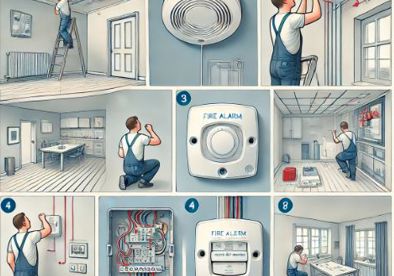Home / Articles / Step-by-step guide for installing fire alarms in residential buildings
Step-by-step guide for installing fire alarms in residential buildings

The installation of a fire alarm system in apartment buildings is an important step in ensuring the safety of residents. Properly installed equipment allows you to quickly detect a fire and prevent its spread. Let’s look at the step-by-step process of installing a fire alarm system in a residential building.
Preparing for installation
Prior to installation, it is necessary to carry out preliminary preparations, which include an analysis of the facility, selection of equipment, and design of the system.
- Evaluation of the object. An inspection of the building is being carried out, and places of increased risk of fire are being identified: electric utility rooms, kitchens, basements, and attics. Escape routes and alarm placement points are analyzed.
- System selection. Depending on the type of building, addressable or non-addressable fire alarms are installed. Addressable systems allow you to accurately determine the location of the sensor, while non–addressable systems record the fact of a fire in the general circuit.
- Project development. A diagram of the location of sensors, cable routes, control panels and warning devices is being drawn up. The project is approved in accordance with fire safety standards.
Installation of equipment
After the preparation, the installation of the fire alarm system begins.
- Laying of cable lines. Cables are laid on walls, ceilings or inside cable boxes. When using wireless systems, transceivers are mounted.
- Installation of detectors. Smoke, heat or combined sensors are placed in accordance with the design documentation. They are installed on the ceiling in rooms, corridors, stairwells.
- Installation of the control panel. The central unit is located in a convenient location for maintenance, usually in the concierge room, control room or on the ground floor of the building.
- Connection of the notification system. Sirens, light displays and other devices are being installed to notify residents of a fire.
- Connection to the power supply system and backup sources. The PS is connected to the main network and rechargeable batteries, which ensure operation during a power outage.
Testing and launch
After installation, the system is configured and checked.
- Hardware programming. The central panel is configured, and addresses are assigned to sensors (for address systems).
- Health check. Sensors, a control unit, sirens, and backup power are being tested. Simulating smoke or heating allows you to verify the correct operation of the system.
- Instructing residents. Responsible persons get acquainted with the principles of the PS operation, the procedure for dealing with a fire and the rules of equipment maintenance.
Maintenance and operation
After commissioning, it is important to carry out regular maintenance of the system.
- Sensors, control panel and sound signals are checked monthly.
- The performance of the entire system is tested quarterly.
- A complete diagnosis and replacement of faulty components is carried out annually.
Proper installation of a fire alarm system in a residential building allows timely detection of fire sources and prevention of serious consequences.
| Order the installation of a fire alarm system
03.04.2025
935 👁